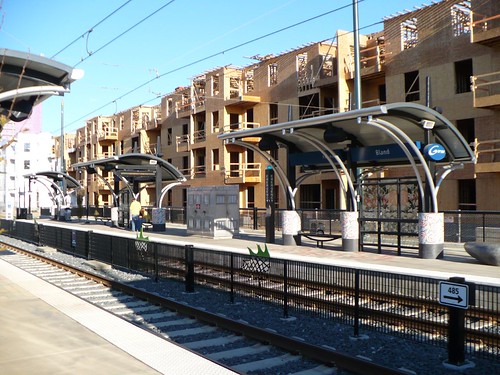For example, the Twin Cities has a number of job clusters that could be made walkable if given a push. It's quite possible that this is a better way to look at transit possibilities, rather than the traditional hub and spoke. Jared makes this point, but the proof is in how our regions are laid out and how people already commute. I don't have the maps here now, but most of the major clusters in the twin cities draw residents from around that cluster. Meaning many people live closer to where they work than we might have thought, they just don't live close to the major center of the region, but rather thier own major cluster.
 This all leads up to talking about how to fill in the centers and connect those people to thier cluster. Chris Leinberger talks about Walkable Urbanism and building up centers. You can see this in DC where places have grown up around the Metro lines. In other regions, places have grown up where there are metro lines such as Atlanta, but also have grown densely but not as walkable in other places. Many of these places could be added to and reconfigured for walking.
This all leads up to talking about how to fill in the centers and connect those people to thier cluster. Chris Leinberger talks about Walkable Urbanism and building up centers. You can see this in DC where places have grown up around the Metro lines. In other regions, places have grown up where there are metro lines such as Atlanta, but also have grown densely but not as walkable in other places. Many of these places could be added to and reconfigured for walking.I once thought Phoenix would be hard pressed to change its ways. But it has really good bones and a regional grid that is almost unmatched in the United States. There are also two major places outside of downtown that could be even more dense than they are today with greater access. They could already support high capacity transit, the one area north of downtown just got attached to the new light rail line.
North Central
 Camelback Road
Camelback Road
But you also have to do it right. In my travels to Denver, I noticed that the Tech Center which has the most jobs outside of downtown has fairly lousy access to the light rail line. This place will not transform as easily as it might have with the line running straight through the center of the density existing, density you can tell was created by cars.
Denver Tech Center
 These pop up in other regions as well, and usually represent the best place to connect downtown with another major job center. These corridors also make for the best starter transit lines, especially if you're having to work with the cost effectiveness measure, because you're going to get the most riders from them. Houston knows this for certain, because in connecting Downtown to the Medical Center, they were able to build the highest passenger density new light rail line in the United states.
These pop up in other regions as well, and usually represent the best place to connect downtown with another major job center. These corridors also make for the best starter transit lines, especially if you're having to work with the cost effectiveness measure, because you're going to get the most riders from them. Houston knows this for certain, because in connecting Downtown to the Medical Center, they were able to build the highest passenger density new light rail line in the United states.Medical Center and Rice University
 In Atlanta, it's Peachtree outside of Downtown on MARTA and Buckhead just a bit further north. The point I've been trying to make is that more of these places could be created and ultimately connected together in a web with better transit. But it's much easier to demonstrate in pictures than with just words.
In Atlanta, it's Peachtree outside of Downtown on MARTA and Buckhead just a bit further north. The point I've been trying to make is that more of these places could be created and ultimately connected together in a web with better transit. But it's much easier to demonstrate in pictures than with just words.Peachtree
 Looks kind of like Arlington no?
Looks kind of like Arlington no?
Buckhead Station in Atlanta
 Which kind of looks like Bethesda
Which kind of looks like Bethesda
The biggest thing I think we see here is how if there is a station, the density fills in between the lines. The Phoenix example is just density for cars, not people. This all can change though, and more centers could pop up around the region to foster more walkable urban development. These centers need to be connected by transit, and if connected, will follow Jarrett's ideal:
If you want a really balanced and efficient public transit system, nothing is better than multiple high-rise centers all around the edge, with density in the middle, because that pattern yields an intense but entirely two-way pattern of demand. If balanced and efficient transit were the main goal in Los Angeles planning, you'd focus your growth energies on Westwood, Warner Center, Burbank, Glendale and perhaps new centers in the east and south, while continuing to build density but not necessarily high rise in the middle.This way we can accommodate the complete market for housing, not just the segment that is single family, and most can have access to quality transit. We can also cut down on VMT while serving our polycentric regions with quality transit of all types.



